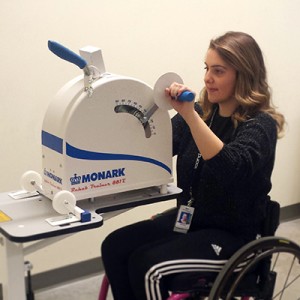Lay summary by Lana To
Edited by Rona Herzog, Crystal Han
This is a lay summary of the research article by ICORD researchers Dr. Tania Lam, Alison Williams, Amanda Chisholm, Andrea Lynn, Raza Malik, and Gevorg Eginyan. Read the original article here.
What is upper body training, and why is it important?

There is evidence that upper body training can improve not only cardiorespiratory fitness and aerobic capacity, but also seated balance in people with a spinal cord injury (SCI). Arm crank ergometry (ACE) is a common and effective upper body training technique used in adaptive sports and fitness programs to target health-related benefits for the SCI community. However, it has not been conclusive that ACE is a promising intervention for improving trunk muscle activity in those with an SCI along with their fitness.
So why look into upper body training? Decreased participation in physical activity is common for many individuals with an SCI. This creates a concern because inactivity is often associated with increased risk of secondary health issues including cardiovascular disease, diabetes, obesity, osteoporosis, and a decrease in mental health. Upper body training is a good way to prevent these secondary health issues, while improving quality of life and functional abilities in people with an SCI. This study is intended to improve fitness while also eliciting trunk muscle activity by developing a true spin program using ACE that include unsupported posture bouts.
What was the purpose of the study?
The purpose of this study is to determine the effects of ACE spin training on trunk muscle activation, seated balance, and aerobic capacity. Researchers made their assessments within 2 weeks of the start and end of the study.
The study’s main goal is to:
- Understand changes in trunk muscle activation following ACE training.
- Confirm that there is an increase in aerobic capacity after ACE spin training
- Determine the effects of ACE spin training on the control of seated balance in those with an SCI
How was the study conducted?
Patients included in the study were individuals with SCI for more than a year and have near normal upper limb range of motion with no musculo-skeletal injuries. All participants had to complete 5 weeks (3x/week for 60 minutes) of a group ACE spin training program which featured modifications of spin class components. This included a variety of cadence and resistance, as well as sitting (unsupported and supported) elements that are similar to standing up vs. sitting components in conventional spin. Participants used height-adjustable arm crank ergometers and followed a training routine that targeted 3 areas:
- Cadence and resistance ergometery exercises challenged the cardiorespiratory system
- Switching between back-supported and unsupported durations of spin training challenged postural control. In back supported exercises, participants had a back rest during the exercise. In unsupported exercise, they did not have the back rest.
- Static sitting tasks challenged seated balance control. Participants were instructed to sit as still as possible for 60 seconds with eyes open and closed for static tasks
What were the results?
The researchers found:
- Confirmation that unsupported ACE training was effective for engaging trunk muscles, resulting in increased activity in trunk muscles
- Peak oxygen consumption improved by an average of 16%; this means that participants were able to deliver more oxygen throughout the body which helps with performance in exercise
- Static sitting balance improved when participants had their eyes closed
- No significant improvements in static sitting balance with eyes open
- Significant activation of trunk muscles was seen in certain participants
- On a Likert scale, all participants rated their enjoyment of the program a 4 or 5, illustrating strong enjoyment
Why are the findings important for the SCI community?
This information can change the way we think about and engage in upper body training for those with an SCI. Positive results related to unsupported ACE training on the activation of trunk muscles for participants with an SCI who experience loss of all motor and sensory function below the level of injury will further open avenues of research into treating SCI complications. Increased levels of trunk muscle activity, along with improved seated balance control, is beneficial to those in the SCI community. The improvement in postural stability while sitting can be promising for people with an SCI to independently do everyday activities which certainly contributes an improved quality of life.
[Definitions of specific terms]
Cardiorespiratory fitness is the maximum amount of the circulatory and respiratory systems to supply oxygen to the muscles
Aerobic capacity is the greatest amount of oxygen consumption the body is using
Seated balance is the steadiness to maintain an upright position without support.
Musculoskeletal injury is injury related to muscular or skeletal systems

